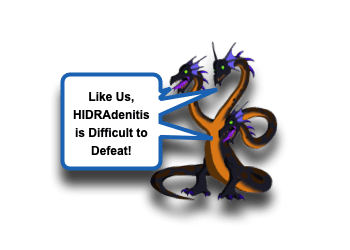Hidradenitis Suppurativa in Children

We manage many skin infections in the Pediatric ED. From Tinea Capitis to Perianal Strep, we see infections from the top to the bottom. Some are fun to say, like Intertrigo, while others are scary to see, like Staph Scalded Skin Syndrome. Sometimes, that skin infection is more than superficial and forms an abscess. We’ve discussed whether Incision and Drainage alone is enough in these case and we have also discussed when to consider not rushing in with a scalpel (Breast Abscess). We have also discussed perhaps a better technique for draining an abscess (Loop Drainage), but we should also consider the unique condition that may not benefit from drainage in the ED. Let us take a minute to ponder Hidradenitis Suppurativa in Children:
Hidradenitis Suppurativa: Basics
- Hidradenitis suppurativa (HS) is a Chronic, Recurrent Inflammatory disorder of the hair follicles and apocrine glands. [Choi, 2020; Riis, 2020; Liy-Wong, 2015]
- Likely due to combination of genetic and environmental factors.
- Pathogenesis believed to be related to:
- Follicular hyperkeratosis and occlusion
- Rupture of occluded region
- Release of follicular contents (keratin and sebum) into the surrounding dermis.
- Inflammatory response to follicular contents
- Abscess formation
- Development of biofilms that sustain chronic inflammation
- Chronic inflammation leading to scarring
- Present as painful, inflammatory lesions in intertriginous areas (axillae, inguinal, anogenital). [Choi, 2020; Liy-Wong, 2015]
- Chronic inflammation, irritation, scarring can negatively impact patients’ recreational activities, schooling, and psychosocial health.
- Known to negatively impact quality of life.
- Complications include:
- Lymphedema
- Fistulae formation (to local structures like rectum or urethra)
- Anemia, from chronic inflammation
- Typically seen in young adults, but there is an increasing prevalence in children. [Choi, 2020; Garg, 2018; Liy-Wong, 2015]
- 2-7% of cases are “early-onset.”
- Almost all (96.8%) cases are in children > 10 years of age.
- Highest pediatric incidence is in female adolescents, 15-17 years of age.
- Patients with “early-onset” of HS tend to have a few specific characteristics:
- Obesity
- Metabolic Disorders (ex, Diabetes)
- Hormonal Imbalance Disorders (ex, premature adrenarche)
- Inflammatory Bowel Disease
- Inflammatory Joint Disease
- Down Syndrome
- Higher rates of Acne
- History of anxiety and depression
- Family history of HS
Hidradenitis Suppurativa: Management
- Hidradenitis suppurativa is a clinical diagnosis. [Choi, 2020; Liy-Wong, 2015]
- Bedside Ultrasound can prove to be helpful. [Wortsman, 2016]
- Can identify subclinical cases.
- Can see cysts, pseudocysts, and fistulous tracts.
- Evaluation should be based on history and physical exam.
- Low threshold for finger stick glucose.
- May warrant outpatient work-up with lipid panel thyroid testing, hormonal testing, and pelvic ultrasound.
- Bedside Ultrasound can prove to be helpful. [Wortsman, 2016]
- Categories – Hurley Staging [Choi, 2020; Liy-Wong, 2015]
- Hurley Stage I
- Single or few small (pea-sized) isolated nodules – often mistaken for ingrown hairs or acne
- No sinus tracts or scarring
- Hurley Stage II
- Recurring boils with small sinus tracts between them
- Scarring can be seen, normal skin between those scars.
- Hurley Stage III
- Multiple boils with multiple interconnected tacts.
- Hypertrophic scarring with no normal skin between them
- Dermal contractures can also be seen.
- Hurley Stage I
- Therapies: [Choi, 2020; Liy-Wong, 2015]
- HS is a chronic problem with acute exacerbations… therapies need to weigh risk and benefits of their longterm implications.
- If there is an underlying co-morbid condition (ex, diabetes, Crohn’s), therapies should be aimed at optimizing management of that condition.
- Pediatric recommendations are largely based on adult experience.
- Antibiotics:
- Topical often used, but efficacy is questioned.
- Used for Hurley Stage I.
- Topical Clindamycin in combination with Benzoyl Peroxide cleansing.
- Oral Doxycycline is antibiotic of choice
- Used for Hurley Stage II.
- Tooth staining not an issue for patients with adult dentition
- Fortunately, HS not often encountered in patients < 8 years of age (more typically adolescents)
- Clindamycin and Rifampin, Erythromycin, and Metronidazole have also been used in children.
- Topical often used, but efficacy is questioned.
- Systemic Retinoids:
- Have anti-inflammatory prosperities and affect the hyperkeratinization.
- Isotretinoin may be used in patients > 11 years of age.
- Immunmodulators:
- Used for Hurley Stage III.
- Adalimumab is FDA-approved for patients above 12 years of age with HS.
- Used for patients with Crohn’s Disease, Psoriasis, and Juvenile Idiopathic Arthritis also.
- Surgery:
- Several surgical techniques described, from minor “de-roofing” to extensive excision.
- Laser therapies also available.
- Recurrence or occurrence at another region can still occur.
Moral of the Morsel
- Just like a Hydra! Hidradenitis can become complex with multiple tracks and is difficult to treat. It is often not cured by an incision.
- First do no harm. While your inclination may be to cut abscesses, remember that underlying issue is not a simple subcutaneous puss collection.
- Think of comorbid conditions. Hidradenitis suppurativa in children is often related to other systemic disorders.

